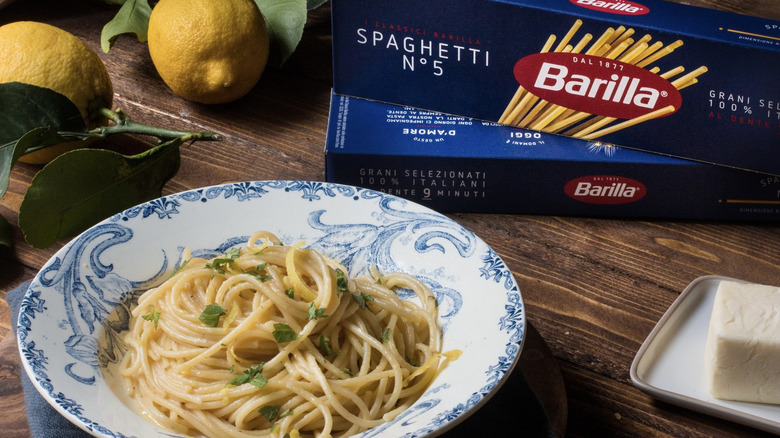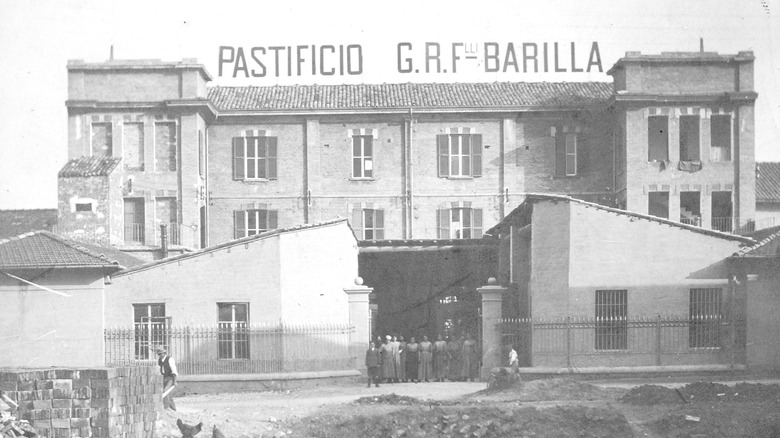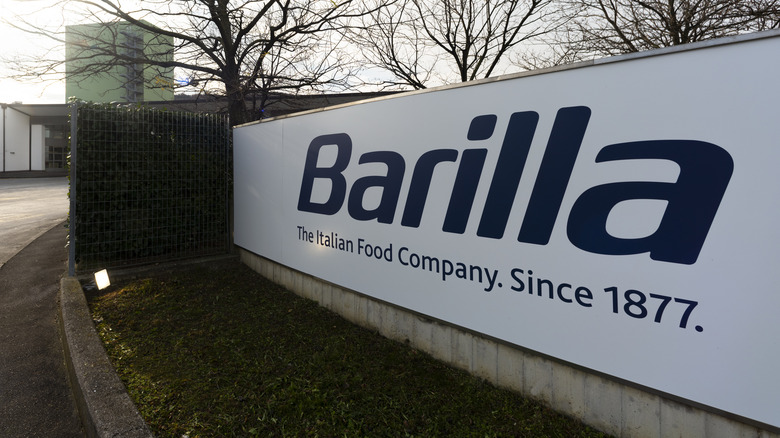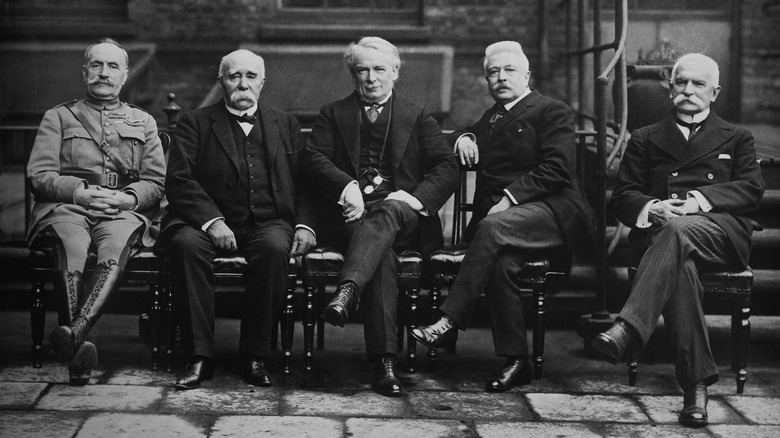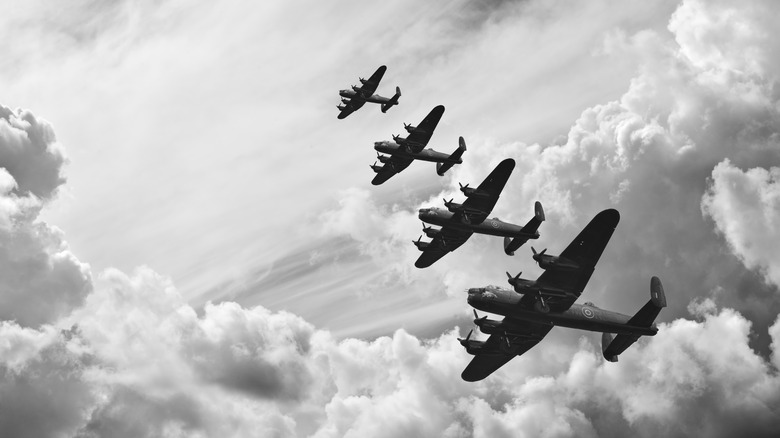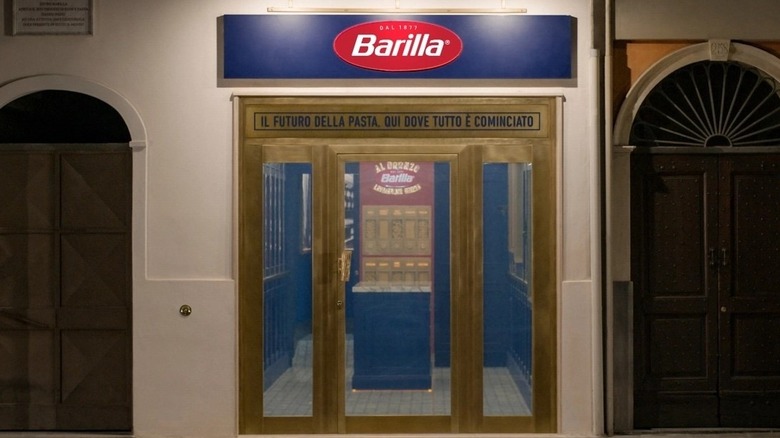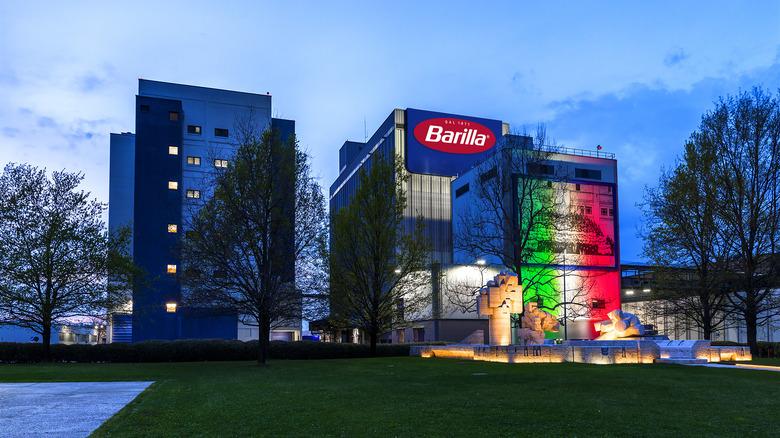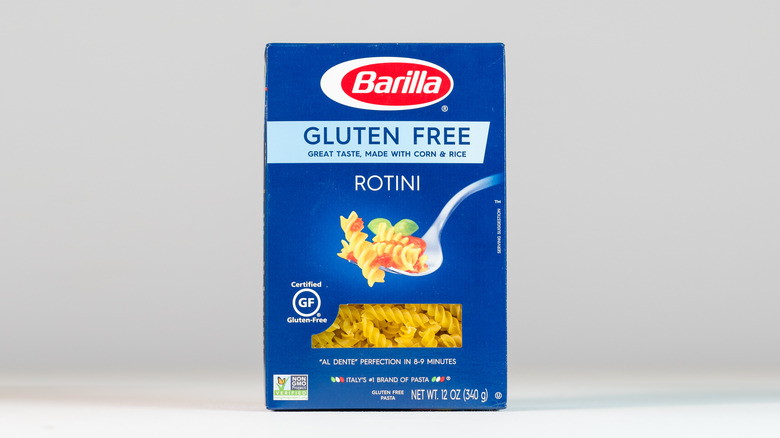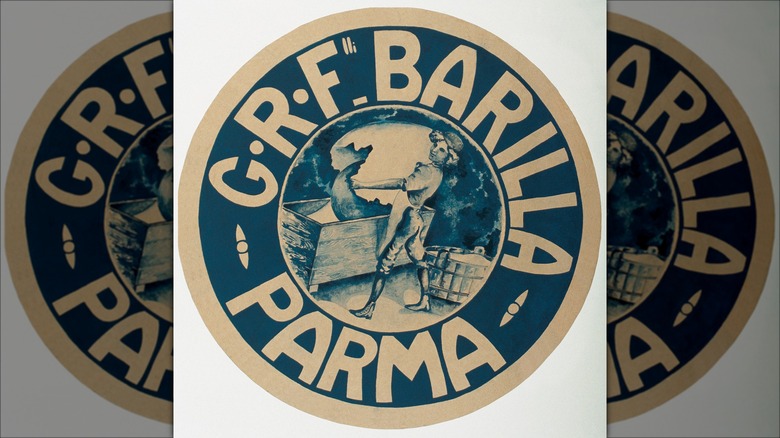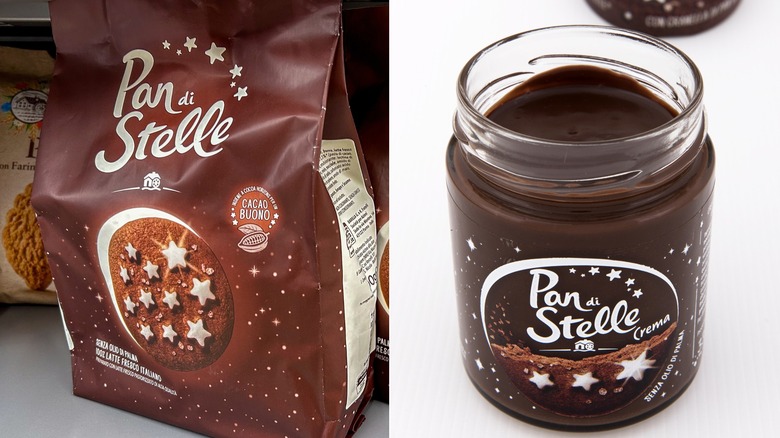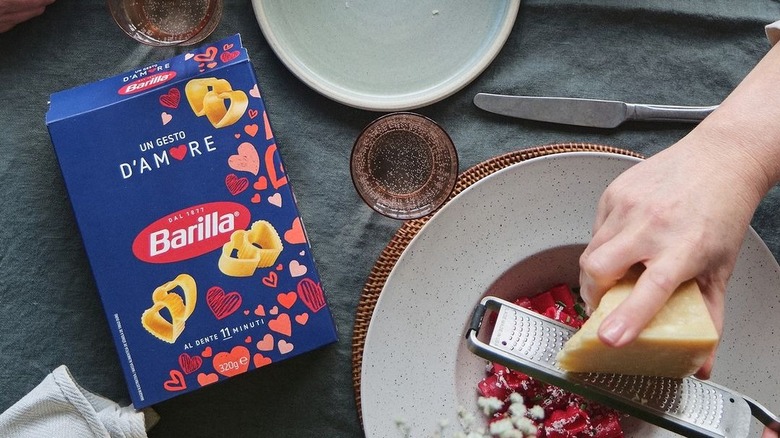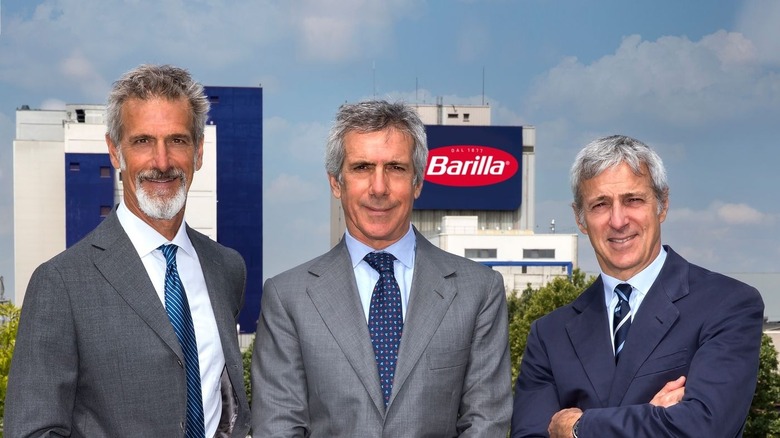The Family-Focused Origin Story Of Barilla
Barilla is a household name when it comes to pasta, and its deep blue box with its red-and-white logo is one of the most recognizable packaging in the pasta aisle. But this state of affairs didn't just spring out of nowhere. Through business savvy, good investments, and especially strong family ties, this company has come a long way since it opened in 1877 as a simple bread and pasta shop in Parma — the birthplace of some of Italy's best foodstuffs, like Parmesan cheese and prosciutto (also known as Parma ham).
Indeed, the story of Barilla's rise from modest bakery to colossal empire — which sells not only pasta but also an array of sauces and owns several subsidiaries that make a range of cookies and crackers — is the stuff of legend. This is why Tasting Table reached out to the company to get an insider's view on the series of events that took the Barilla company, and the family that runs it, to where it is today. So let's go back to the very beginning and find out how the company started out, weathered two World Wars, and continues to provide good quality pasta and other products at every turn.
Barilla started out as a bread and pasta shop
It's hard to imagine that a company as widespread and prolific as Barilla once fit into a tiny shop just off the cobblestoned streets of the small city of Parma in northern Italy. Yet in 1877, when Pietro Barilla Sr. opened the first Barilla pasta and bread shop, he hardly could have known what was to come.
That said, Pietro didn't start out with nothing. A Barilla spokesperson tells Tasting Table in part that "making bread and pasta by hand was a time-honored family tradition that began long before [this]." Indeed, he was born into a family that already knew the trade inside and out. Pietro's grandfather, Vincenzo Lanati, already owned Lanati Bakery. For his part, Pietro grew up practicing the craft alongside his two elder brothers, perfecting it until he was ready to strike out on his own. With an entrepreneurial spirit and a good product — which at the time consisted only in various breads and pasta shapes made entirely by hand — the Barilla company was well on its way.
The first factory opened in 1910
In the 19th century, one can only imagine that things moved a lot more slowly than they do today, especially when it comes to the industrialization of products. So it should come as no surprise that it took more than 30 years for the small Barilla bread and pasta shop to grow out of its britches and start thinking bigger. But the ball was rolling and there was no stopping it.
In fact, Barilla was able to open not only two more shops in 1910, but also a large pasta plant that "allowed the company to go from artisanal to industrial production," the Barilla team explains to us in part. Suddenly, the Barilla company was the proud employer of a whopping 80 workers, who reportedly produced eight tons of pasta and two tons of bread daily, according to its website. This was a marked increase from the two-and-a-half tons per day the Barilla family was said to produce in their shop on their own in 1905. This was made possible by the presence of an industrial continuous baking oven.
By this time, Pietro Barilla Sr.'s sons, Riccardo and Gualtiero Barilla, had also joined their father in running the business, providing a further boost to operations. Soon, more and more people in and around Parma were learning about and savoring Barilla's products.
Barilla continued production throughout WWI
Although Pietro Barilla Sr. passed away in 1912, his sons, Riccardo and Gualtiero Barilla, were already well versed in running the business on their own. They continued to do so through some of the toughest years in Italian history, which was only made tougher by Gualtiero's passing in 1919 from typhus. Not only that, but Barilla headquarters was taken over by the regional armed forces during the World War I and made the official ration supplier of the military, including for troops at the front.
Barilla came out of this situation even stronger than before, reportedly producing more than 30 tons of pasta per day and employing 300 people in its plant. But WWII was just around the corner, and things were about to get worse before they got better. Luckily, Riccardo had the support of his wife, Virginia Barilla, who is credited as the one who convinced Riccardo to undertake the massive expansion that would ultimately lead to Barilla's modern-day success.
Production amped up in time for WWII
Before WWII reared its ugly head, Riccardo and Virginia Barilla's son, Pietro Barilla Jr., joined the company in 1936 — just in time to develop a widespread commercial network to more easily bring the Barilla pasta to market. This endeavor was aided by the adoption, that same year, of six continuous presses, which allowed workers to mix, knead, and press the dough in one ingenious machine.
Thus, just ahead of WWII, Barilla was reportedly producing around 80 tons of pasta daily. It was made by some 800 employees. Even so, expansionist plans had to be put on hold, or at least altered, during the war years. Rationing was again imposed, and the company was at the mercy of trade barriers as the fascist regime took hold. Barilla continued production and stayed relevant through these years in part by obtaining orders from the government and military, and by supplying its products to settlers and soldiers in the East African countries Italy was trying to colonize.
It's said that Barilla also was able to make some important technological advances in production and communications for the business. As a Barilla spokesperson explains to us, "... We were using the most cutting-edge pasta and bread machines."
Riccardo Barilla's sons took over the business after the war
As Italy emerged from WWII in 1945 and rationing ended two years later, Pietro Barilla Jr. and his brother, Gianni Barilla, took over the family business. The former brother handled trade and communications, and the other took on the administrative, production, and buying departments, as the Barilla team tells us. The reopening of the economy allowed Barilla to breathe new life into its expansionism plans, leaning on the company's technological advances.
This expansion was in part informed by a fateful visit Pietro Jr. made to the United States in 1950. Although it would be many decades before Barilla officially entered the market there, this trip was formative in many ways. Pietro Jr. learned of new and innovative ways to advertise and sell products for a mass market. He also adopted new packaging strategies, including by instituting cardboard boxes. In short, Pietro Jr. applied lessons he learned on his trip to the big expansionist push that Barilla conducted in Italy in the 1960s.
Production at Barilla soon expanded
Hot on the heels of Pietro Barilla Jr.'s visit to the U.S., he and Gianni Barilla set to work on their plans of grandeur. With a higher demand for Barilla products, a Barilla spokesperson explains that the company purchased some land and built Pedrignano — which was said to be world's largest pasta factory — in Parma. And indeed, if you build it, they will come: This new plant, which operated across a single floor instead of several stories, has reportedly been able to produce 1,000 tons of pasta daily, as of 1969.
But innovation was only one side of the story. Barilla was also investing in new markets, and in 1965, the brothers introduced packaged bakery products like breadsticks and crackers. Sadly, the family previously had to close the fresh bread bakery to focus on these new activities — but hey, no one can have it all.
A flurry of acquisitions ensued
By entering the packaged goods market, Barilla hit a turning point, after which progress for the company became exponential. Over the ensuing decades, it started buying other prominent pasta brands throughout Italy and Europe, including Voiello, the Greek brand MISKO, and Pavesi, a historical Italian biscuit company. Not only that, but in 1975, Barilla launched a whole new brand of baked goods and called it Mulino Bianco — which today is another of the most recognizable and popular brands in Italian supermarket aisles. In 2014, Barilla finally introduced gluten-free pasta, in keeping with the growing demand for such products in Italy and beyond.
All of this was made possible, in part, by Barilla's newfound commitment to innovative advertising — one of the tricks Pietro Barilla Jr. had picked up on his trip to America, as previously mentioned. The company had long since been using the radio to advertise its products. But by the 1960s, Barilla was leaning heavily on television — including through an ad campaign fronted by Mina, one of the most well-known and popular singers in Italy at the time.
A marvel of packaging
Careful attention made to packaging also played a role in Barilla's expansion. It didn't take Pietro Barilla Jr. long to realize that packaging impacted the branding and advertising of a product. Indeed, a brand that can be easily recognized through its packaging is more likely to be remembered and purchased. But in Barilla's case, the packaging seems to be more than that, as it's said to honors its roots. The Barilla team tells Tasting Table that the only material available in which to store fresh pasta when the company opened its industrial plant in 1910 was a sugar paper that happened to be blue. The spokesperson says that the today's classic blue box pays tribute to that original sugar paper packaging.
The oval logo on the Barilla box has a similar story. Because it used to require a great deal of eggs to make fresh pasta in the early days, the company's original logo featured a boy carrying a very large egg. Although most Barilla pastas no longer contain eggs and are mostly vegan, the tradition of the logo has endured, albeit with some modifications.
Pietro Barilla Jr. has become an iconic figure
After Pietro Barilla Jr. died in 1993, his sons, Guido, Luca, and Paolo Barilla, took over the company. But while Pietro Jr. is gone, it seems he is far from forgotten. Barilla saw some of its most significant expansions during his tenure. And so, on what would have been his 100th birthday in 2013, celebrities, industry titans, politicians from both sides of the aisle, and other important personages gathered to celebrate his life at an event in his hometown of Parma.
Remembering Pietro Jr. was not just about highlighting pasta, as glorious as the food may be. It was about reminding anyone who cares to listen that Barilla is and will always be a family business. In the words of Pietro Jr. himself, as reported by The New York Times, "Barilla is not a brand, it is my family name." In other words, as important as branding may be, let us not forget that Barilla stands for family. This is exemplified, for instance, in its 1952 advertising catchphrase, "With Barilla pasta it's always Sunday" — or, the day Italian families typically gather for long and leisurely lunches.
Barilla is more than just pasta
In its quest of greatness, Barilla has managed to take control of the market for some of Italy's — and the world's — most popular foods. Aside from the obvious pasta options, though, Barilla's ownership of the Mulino Bianco line of baked goods also means that it holds a special place in the hearts of Italian families when it comes to chocolate biscuits.
Nowhere was this most evident in the fairly recent feud between Barilla and Ferrero — another Italian packaged food juggernaut and the maker of the world-renowned Nutella spread. In 2019, Ferrero first introduced a dangerously compelling new treat known as Nutella Biscuits, which are made up of plain biscuits enclosing a rich, creamy Nutella center. Mulino Bianco, which is known for its Pan di Stelle chocolate breakfast biscuits, had just launched its own new line of cookies, Pan di Stelle Biscocrema. It consists of the signature chocolate biscuits enveloping a center of hazelnut cream ... which, incidentally, is basically what Nutella is. And so, the Italian companies were essentially treading on one another's territory.
"When it comes down to Barilla and Ferrero, there can be a war," Milan marketing expert Michele Boroni told The New York Times. "It's a competition between Italy's last food giants that have remained Italian." Indeed, although the battle rages on without a resolution in sight, the incident further underscored the reach of Barilla as a brand in Italian meals, from breakfast (or snacks) to dinner.
The company's pasta continues to evolve
Despite these various forays into other culinary realms, as important as the products may be, Barilla continues to be the undisputed king of pasta. And it clearly didn't do this by just sitting on its laurels. The company has remained relevant over the decades due to a constant evolution, regularly putting out new products just when you thought you'd seen everything. For instance, in 2022, Barilla launched its Al Bronzo (meaning "by bronze") line, which is marketed as a premium pasta in a red box. It's made by putting the dough through bronze dies. The company claims that this shapes the pasta in a more roughly textured way, which in turn holds onto more of the sauce you serve with the pasta, rather than letting it slide off.
Barilla also keeps us on our toes around the holidays, releasing pastas that get into the spirit of things. In 2023, for example, Barilla released heart-shaped pasta just in time for Valentine's Day, which is based on its recipe for rigatoni. It's probably safe to say that we haven't seen the end of the evolution of pasta, perhaps in large part thanks to Barilla.
Barilla remains a family affair
Barilla is so widespread in America these days that it's hard to believe it only just officially hit the U.S. market in 1996. Yet that was the year the company did just that when it built its first plant in Ames, Iowa. This gave the company easy access to large quantities of durum wheat. As a Barilla spokesperson tells Tasting Table, from then on, it reportedly only took the company three years to become the leading boxed pasta brand in the U.S.
Now, Barilla produces some 1,000 tons of pasta per day in the U.S. alone, a far cry from the two-and-a-half tons the family was able to make by hand back in Parma at the turn of the 20th century. But while quantities have changed, it seems the family spirit of the company has not. Barilla remains a private, family-owned business, now in its fourth generation, with Guido, Luca, and Paolo Barilla serving as chairmen on the board of directors, according to the Barilla team. However, U.S. and global operations are overseen by the Barilla Group's CEO Gianluca Di Tondo.
